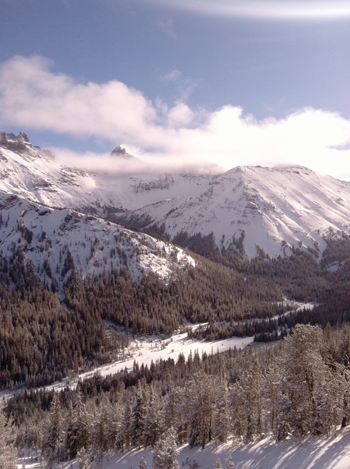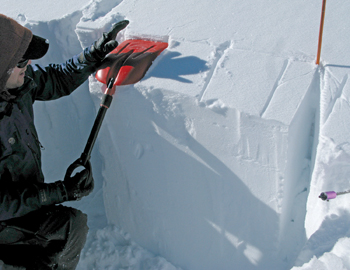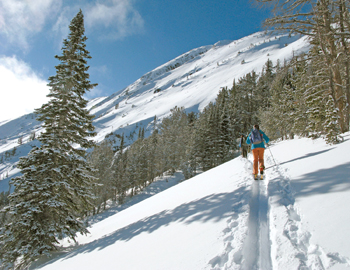The Heart of The Beartooth
Thursday Jan. 31st, 2013
In my heart, mountains have always been sacred places. I know I’m not alone in feeling a deep sense of gratitude for the opportunity to seek refuge from daily stresses or heavier emotions in the undisturbed silence on a snow-covered peak. My inspiration to work harder, push myself further as a skiier, and to be a better person to myself and others grows exponentially the closer I am to jagged peaks tearing holes in wind blown clouds. The mountains surrounding Cooke City, Montana take that inspiration to a whole new level.
My first view of Cooke City came around sunrise on January 11th of this year, following 3 hours of white knuckle winter driving from Bozeman. When I saw the mountains I would be exploring for the next few days, my shoulders dropped away from my ears and I felt my breathing relax. I was amazed that I had been living in Montana for ten years, and had never once ventured into what is undoubtedly one of the most gorgeous spots in our state, and almost certainly some of the most impressive big mountain ski terrain I’ve seen.
This trip wasn’t about finding the best lines or deepest powder; I was here for a Level 1 Avalanche Safety class. After 10 years of skiing the backcountry, I had come to the firm realization that if I actually want to go after the mountain adventures that call to me, I need to feel fully confident in my ability to assess snow conditions, travel routes, and respond quickly and effectively if the unthinkable happened. The course was hosted by Ben Zavora, owner of newly established guiding service Beartooth Powder Guides.
Ben left his native California 20 years ago in pursuit of deeper snow, steeper terrain, and fewer people tracking it out. Bozeman offered Ben the perfect intersection of steep peaks and the opportunity to make a living, first as a mechanic and later building homes for the influx of new residents moving to the Gallatin Valley in the late 90s and early 2000s. The solitude and silence offered by the backcountry soon outweighed the option to make laps at Bridger. He remembers venturing out for days on end with a partner or two in areas that have become local standards without coming across another skier.
As backcountry gear evolved to be lighter and more comfortable, Ben saw a steady increase in the number of people looking for fresh snow beyond the ski area. With increased access came a corresponding increase in accidents – some close calls, and some tragedies. In 2011, Ben followed his passion for being in the mountains by moving to Cooke City full-time and establishing BPG. It’s clear Ben could have made a solid living on guiding skiers into the breathtaking terrain, but his desire to help others make better decisions in the backcountry led him to offering avalanche safety classes like the one I took in mid-January.
Over the course of the weekend I learned a lot about what sets up prime avalanche conditions, how to assess the potential for slides from snowpack layers, and gained confidence in my ability to use the transceiver I bought 5 years ago (and have admittedly spent little time practicing with). I also had some great conversations with Ben about his decision to offer an approach to guiding that inspires clients to take notice of their surroundings, instead of seeing travel between peaks as a means to an end.
“For me, it’s all about getting people out to experience what makes these places so special and to send them home with a desire to protect it.”
It’s easy to see how the couloirs formed by skyrise rock formations and arguably the deepest snowpack in Montana make the Beartooth Mountains unique for skiing. What’s less obvious is how much that skiing is influenced by a unique high alpine ecosystem, specifically the presence of Whitebark Pine; an iconic species for the high peaks of the Western U.S. and Canada. These are the trees that skiers and mountain climbers travel through in the final pitch to get above treeline. They’re tough, and they’re ancient. And, in recent years they’ve been dying off at an alarming rate that can be linked to the impacts of climate change and an invasive fungus.
Retired Forest Service employee and avid skier Jesse Long estimates that over the past 10 years 90% of the Whitebark Pine in the Greater Yellowstone Ecosystem has been impacted by a combination of Blister Rust and the Pine Beetle. As Jesse explained in a phone conversation that was difficult to listen to at times, the decline of Whitebark Pine in our forests will have profound impacts on our landscape and the recreational pursuits that many of us identify as the core reason for living where we do, or the careers we’ve chosen (or abandoned to answer the call of the mountains).
Whitebark Pine create suitable micro-climates for other tree species that would otherwise have difficulty surviving the brutal conditions found above 8,000ft, and their protein-rich seeds are a vital food source for wildlife – including the Grizzly Bear. Several efforts have been made to add the species to the Endangered Species List, only to face denial due to a lack of funding for studies at the federal level. Perhaps hitting closer to home for skiers, the forest canopy created by Whitebark Pine protects high elevation snowpack already at risk due to warming temperatures. As any skier, fly fisherman, or whitewater enthusiast can tell you, less snow and rapid springtime melt means a shorter season and less fun. Jesse was blunt in his assessment of potential consequences: “If you’re a skier you should be concerned about these impacts. We’re looking at really the possible disappearance of winter.”
This year BPG began offering classes to raise awareness of the fragile dynamics of high alpine ecosystems at the local level. As Ben sees it, skiers can harness their love for the steep and deep by advocating for better environmental protection policies at all levels, getting involved with local non-profits, and changing individual behavior. He sees the opportunity to teach others about protecting and preserving their favorite stashes as part of his responsibility as a powder fiend. As he put it:
“Sometimes we have to think about the big picture to protect the things we love.”
To learn more about the classes and guiding services offered by Beartooth Powder Guides visit www.beartoothpowder.com or e-mail info@beartoothpowder.com. To learn more about efforts to protect and restore Whitebark Pine and high alpine ecosystems visit www.treefight.org
Shannon Hughes is a writer and marketing strategist who seeks silence and adventure in the mountains. She will be continuing her research on ski terrain out of Cooke City as often as her budget and work schedule allows this winter. She can be contacted at shannon@spur-studio.com
| Tweet |